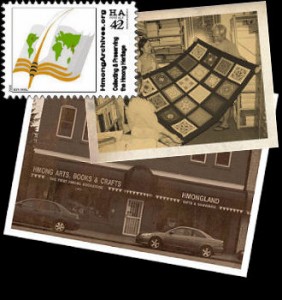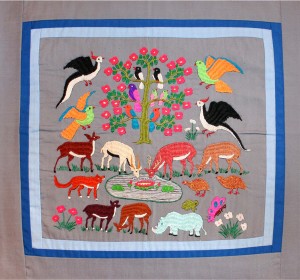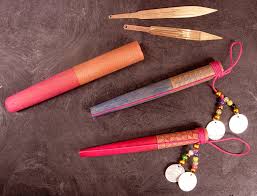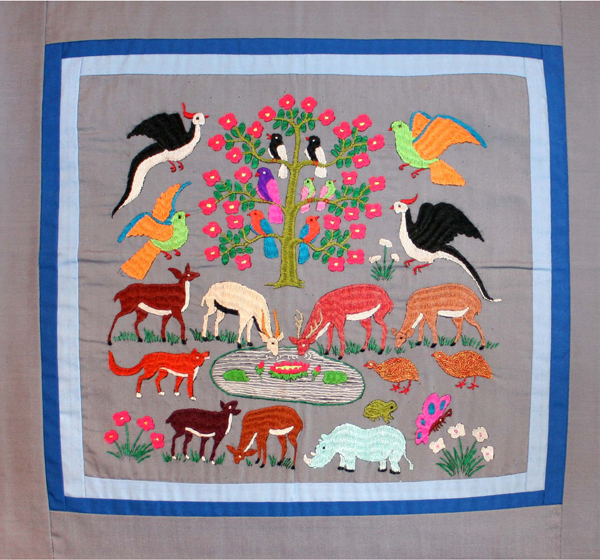Hmong Archives: Preserving the Hmong Heritage in St. Paul, Minn.
by Dawn Wing
Friday – March 26, 2013.
At first glance, the charming two-story building is no different from the residential homes surrounding it. Since 2010, 343 Michigan St. has been home to the Hmong Archives, the only non-profit archives dedicated to Hmong culture in the United States. Upon entering, fellow APALA member and former Hmong Archives volunteer and Minnesota-native Mee Xiong and I were greeted warmly by Kou Xiong, a long-time volunteer of the Archives who gave us a tour.

Hmong Archives was founded in 1999 by Yuepheng Xiong of Hmong Arts, Books and Crafts (or Hmong ABC) with the support of Twin Cities Hmong professionals, Minnesota State Representative Steve Trimble, and retired Minnesota Historical Society librarian, Marlin Heise. Its purpose is to research, collect, preserve, interpret and disseminate materials in all formats about or by Hmong people. From 1999 to 2010, the Archives moved to six different locations due to space constraints and funding. Currently, with a growing collection of over 153,000 items, the Archives is now housed at the home of its curator, Mr. Heise. The Archives relies primarily on private donations and grants for its daily operations. It is completely run by volunteers.
Mr. Heise, who was doing research and visiting Hmong students in Vientiane, Laos, was unavailable at the time of our visit. He is primarily responsible for the Archives’ growing acquisitions, as well as conducting outreach and organizing volunteers. Mr. Heise has been actively engaged with the Hmong community and interested in collecting Hmong artifacts since the early 1980s. Mr. Heise’s efforts began with mentoring two young Hmong interns at the Minnesota Historical Society, which grew into developing relationships with the larger community. My gracious tour guide Mr. Xiong is also an expert of the Archives collections himself. He started as an intern over ten years ago and has remained on staff ever since.
Hmong Archive is special. There is no security front desk asking visitors to identify themselves and lock their belongings away. It is very much as cozy and welcoming as it appears from the building’s exterior. Every part of the house’s interior is packed with cabinets and shelves of documents, audio cassette tapes, CDs, DVDs, videotapes, and books in Hmong and other languages.
The Archives contains 13 collections: Archival Boxes, Audio, Books, Cards, Files, Maps, Newspapers, Objects, Periodicals, Photographs, Posters, Videos, and Works of Art. Starting with the first floor, Mr. Xiong showed us Hmong cassette tapes in a cabinet and books stored in floor-to-ceiling shelves. The second floor was also filled with shelves of materials. Mr. Xiong explained the wide variety of VHS and DVD movies made by or about Hmong, including “Gran Torino.” A film buff, Mr. Xiong asserted that the movie collection is a great and exciting way for Archive users to learn about the progression of contemporary Hmong American film production.

Also in the same room on the second floor, were shelves of CDs of traditional and popul ar Hmong music. Mr. Xiong showed us photocopied articles and photographs of Hmong refugees in Thai camps after the Secret War. These were also available on the second floor of the Archive. Lastly, Mr. Xiong took out traditional Hmong story cloths which are stored in archival boxes. Taking one colorful story cloth after another, he tells me the meaning of patterns, narrative and animal symbolism according to Hmong folklore. Many of these can be viewed online at Hmong Embroidery, which was a collaborative web project between the Archives and Hmong Cultural Center.
The collections go beyond just your typical books and multimedia items. The Archives possesses unique cultural items such as a 1940s Luang Prabang-style black powder rifle which is over 6 feet long. Mr. Heise enjoys allowing college visitors to handle the weapon and ask them to envision using one for hunting in the mountains of Laos. Heise also describes another special item, a Thai-made aluminum rice pot, which to him represents the Hmong experience.
“To me, its shape is beautiful, but what are the stories it could tell about cooking fires in Long Cheng, Laos, or Ban Vinai Refugee Camp in Thailand, or resettlement in St. Paul? If only it could talk!,” says Heise.
A favorite item for Hmong elders who visit the Archives is the khib or A-frame used for loading firewood or grass. According to Heise, many of these visitors are reminded of fieldwork they have done in their homelands and wish to wear them when they see it. Besides story cloths, other unique Hmong handmade items include wooden carved airplanes by 10-year-old Nou Xiong from Nong Phue village, Xieng Khuang, Laos. Heise added these to the aeronautical collections at the Archives.

Researchers from around the world visit and contact Hmong Archives, from Austria to China. Mr. Heise and the Archives volunteers assist with research questions dealing with topics such as Hmong jaw harps or ncas, the Secret War in Laos and discovering the Hmong word for “gay.” With their collective knowledge of the Norwegian, Danish, German, Hmong, Lao, Thai and Chinese languages, the staff translate materials into English so that they are more accessible to users. The Archives has loaned objects to a Chicago museum and to Twin Cities organizations.
As for the future of Hmong Archives, Heise states, “Hopefully we will move into a large, archivally and environmentally friendly building in a Hmong neighborhood. This building should accommodate several Hmong nonprofits that will mutually benefit us by co-location.”
For now, the Archives has plenty of projects to keep its staff busy, such as cataloging all their items and making them available online. They also hope to continue collaborative projects with community partners as they did with Hmong Cultural Center on the HmongEmbroidery.org project.
Make a visit to the Hmong Archives:
343 Michigan Street
Saint Paul, MN 55102
651-621-5469
Business Hours: Monday, Wednesday, Friday from 10am – 6pm. Visitors may come during business hours or by appointment.

